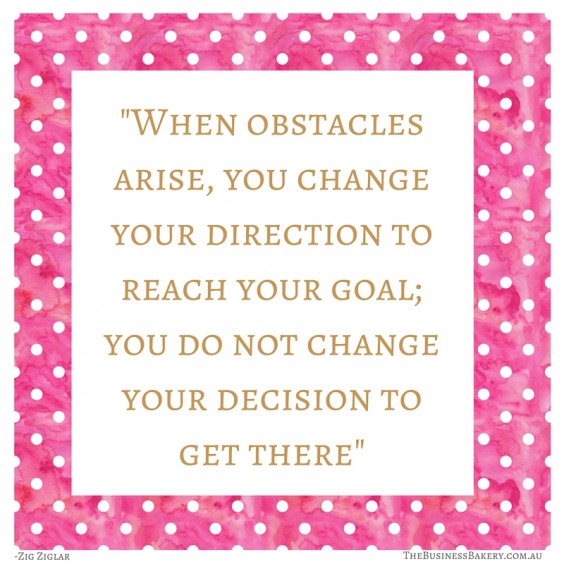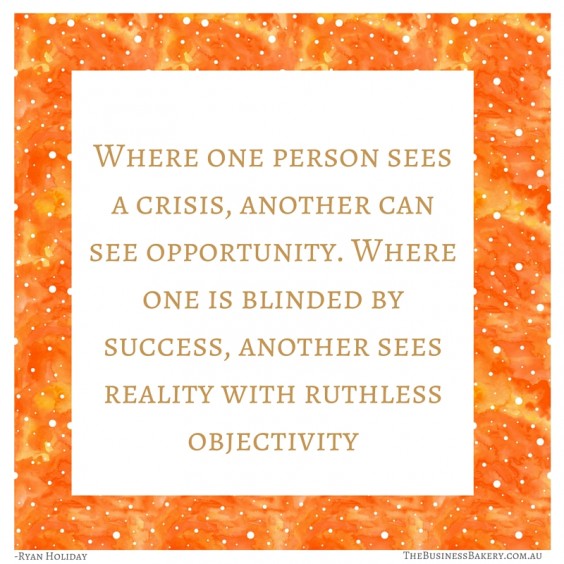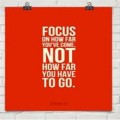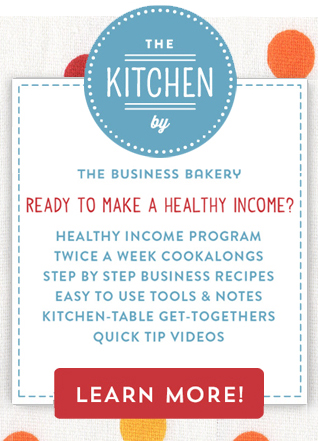What to do when you hit an OBSTACLE (or two) on your way to your 100 Day Goal
Written by Julia Bickerstaff // January 9, 2016 // Daily Juice // No comments
I’ve been reading a book called The Obstacle is the Way by Ryan Holiday. It’s all about how to deal with OBSTACLES and it contains very fabulous advice for what to do when things don’t go according to plan. Sound useful? It is. Read on!

When you started the 100 Day Goal, (or a New Year’s resolution, new business or a new project) you were probably bouncing with enthusiasm and “can do” attitude. But it’s hard to keep that up fades when obstacles start to appear. And appear they do! Not enough time to work on our goals, not enough money, a new competitor, an unsupportive partner, disinterested customers….. I could go on but I think you get the idea.
Because obstacles are a fact of life I think it’s really useful to train yourself to deal with them in a way that means they don’t derail you or cause you overwhelming anxiety. The book The Obstacle is the Way: The Ancient Art of Turning Adversity to Advantage has a little method, excellent advice and some inspiring stories which have helped me look at obstacles differently and I think it will you too! I’d love you to read the book recommend you read the book, but in the meantime here’s a summary of what I’ve learned from it and a little on how you can apply it to the 100 Day Goal. Enjoy!
Uh oh Obstacle ahead!
1 An obstacle is ANY frustrating, unfortunate, problematic, unexpected problem which prevents us from doing what we want to do! (Got any of those?!)
2 In business (and life actually!) there will ALWAYS be obstacles. The question is, can we get past them or will we allow them to crumble us?
3 Whenever there is an obstacle, we have a choice: Be blocked by it, or go through/over/round it.
4 But! Most of us don’t make that choice. We just freeze when we encounter an obstacle. For example we might be thinking about our 100 Day Goal and the obstacles that could possibly lie ahead and that alone might make us feel wobbly and totally unable to do anything (except eat chocolate or drink wine!)
5 Our obstacles are unique to each of us. But we all feel them in the same way: Fear. Frustration. Confusion. Helplessness. Depression. Anger.
“It can feel like an invisible enemy has you boxed in, and is holding you down with pillows” Ryan Holiday
6 The big thing is that obstacles are not only to be expected but embraced. Embraced! In the face of an obstacle we need to be thinking ‘this must be good!’ We should see it as an opportunity to move forward, or go in a better direction. We should do something special BECAUSE of the obstacle. We need to seize it as an opportunity!
A method for dealing with Obstacles
It turns out that what matters most is not what our obstacles actually are but how we see them, how we react to them, and whether we keep our composure. And this really is the li’l method for dealing with the obstacles life throws at us.
- Look at the obstacle OBJECTIVELY (see obstacles as they really are)
- Take ACTION
- Develop the WILL to withstand obstacles

So what does this all this mean?! Read on!
A Look at the obstacle OBJECTIVELY
The first part of the method is to see obstacles simply and straightforwardly, as they truly are. Neither good nor bad. Just a fact. But….
1 Most of us don’t see obstacles objectively. We normally have a perception of obstacles as scary, painful, frustrating, a sign that we ‘shouldn’t be doing what we’d planned to do’, or simply the end of the road.
2 We tend to react emotionally to obstacles, get despondent, and lose our perspective. Ugh, that’s really not good. In fact there’s no faster way to turn a bad thing into a REALLY BAD THING than to fill our mind with unhelpful thoughts.
3 Nothing actually makes us feel this way about an obstacle; we choose to feel that way. An obstacle is just a thing, it’s not “good” or “bad” until we decide it is so!
4 The trick then is to be super-disciplined about how we think about obstacles, or how we perceive them. We need to look at them unemotionally which means we need to do this in a panic free zone!
5 Panicking in the face of an obstacle is totally unhelpful. When we panic, we make mistakes, we override systems, we disregard procedures, we ignore rules, we deviate from our plan. We stop thinking clearly and we just get in a spin from all those panicky hormones racing around inside us.
6 So we need to Cultivate the Art of Not Panicking
7 We need to look at obstacles rationally and clearly, and as an opportunity and NOT as as something to fear or moan about. (I know this is tricky!). While we can’t change the obstacles themselves, we can change how they appear to us. We can change our perspective.

8 Then we can DECIDE the story we tell ourselves about the obstacle.
- We can say “I might not have wanted this to happen, but I decide how it will affect me. No one else has the right”
- We can see the obstacle as an adventure
- We can decide that, just because our mind tells you that something is awful or evil or unplanned or otherwise negative, we don’t have to agree!
- We can say “I resist the temptation to declare this a failure”
- We can say “I don’t agree to let this obstacle intimidate me.”
- We can say “Do I need to freak out about this? No, because I know that that won’t add anything constructive.”
9 So when faced with an obstacle we’re going to try and be objective and calm and choose to see the good in a situation. We’re going to steady our nerves, place things in perspective, be in the present moment and focus on what can be controlled
10 We’ll probably still want to have a good ol’ emotional freak-out when we encounter an obstacle, so this is more about controlling our emotions, rather than pretending they don’t exist. But when that freak out starts to bubble we’re just going to say: “No, thank you. I can’t afford to panic” .
12 We will only overcome the obstacle if we keep our emotions in check (not easy I know!) and focus all our energy on solving the problem rather than reacting to it. We don’t want to overthink the problem because that’ll get us all worked up!
13 Our perception of an obstacle is VERY important, so don’t let the force of an obstacle knock you off your feet. Just say to it: “Hold on for a moment; let me have a good look at you and what you represent” If we don’t do this, we’ll probably believe that the obstacle is bigger than it is and end up all overwhelmed by something actually quite small.
14 If you’re finding it difficult to distinguish between your perception of an obstacle and it’s reality, just think about how you would advise someone else in the same situation. Why? Well when we think about our own obstacles we see them in the context of our emotional baggage whereas when we advise someone else, emotions just don’t come into it. When we look at other people’s obstacles we are objective, with ourselves we have a perception. This is why it’s helpful to talk your obstacles over with others.
15 If part of your baggage is past business decisions that have turned out to be a mistake, you can jettison that! Why? Well you had a hypothesis and it turned out to be wrong. That shouldn’t upset you. It wouldn’t annoy off a scientist, it would help him. You see. it’s all about your perception!
16 Confidence in the face of obstacles isn’t easy Mostly because we were brought up to be realistic or conservative or ‘not rock the boat’. This is an enormous disadvantage when it comes to trying big things because though our doubts (and self-doubts) feel real, they have very little bearing on what is and isn’t possible.
17 We need to focusing only on the things we can change. Every ounce of energy directed at things we can’t actually influence is wasted.
18 When we do get over an obstacle we feel amazing! Psychologists call it adversarial growth “What doesn’t kill you makes you stronger” is not a cliché but fact.
So, look at the reality of your obstacle, keep calm, shake off the bad stuff and soldier on as though nothing has happened. Because (and this is TRUE!) if you hold your nerve then nothing really did “happen” : your perception made sure of that!

B Take Action!
The second part of the method is to take action.
Most of us don’t have the luxury of running away or hiding from our obstacles because WE have something very specific we’re trying to do. No one is coming to save us! The obstacles won’t un-obstacle themselves. And if want to go where we say we want to go—to accomplish our 100 Day goals—there is only one way, and that’s to meet our problems with ACTION. Ta-da
When faced with an obstacle we need to:
1 Act! We’ve all done this…., said: “I am so overwhelmed/tired/stressed/busy” And then we, er, go out and party, or treat ourselves, or sleep in, or wait…. It feels better to ignore the obstacle, but that isn’t going to make it any better. We’ve got to act.
2 Start! We have to start ACTING! Anywhere. Anyhow! We needn’t worry about whether the conditions are perfect. Once we get started, we’ll get some momentum and just MAKE it work.
3 Play it for all we’ve got!
4 Take bold, deliberate and persistent actions
5 “Work hard to turn sh*t into sugar“ Ryan Holiday
6 Greet our obstacles with energy and persistence
7 Understand that while taking action might be risky, or that we might not have the experience or that it might be too expensive, or that we might think something better might come along, WE NEED TO GET ON WITH IT ANYWAY!
8 Sprint not jog
9 Do more! Try harder! Ram our feet into the stirrups and really go for it!
10 Get rid of the millions of reasons why we can’t move at a faster pace
11 Attack problems with the LOTS of initiative and energy
12 Start by saying, “Yes, let’s go.”
13 Create momentum by getting up and getting started.
14 Not get distracted by external chitter chatter.
15 Chisel and peg away at the obstacle until it is gone.
16 Try something new when we have exhausted all the other traditional options
17 Realise that genius is often really just persistence in disguise
18 Refuse to give up.
19 Turn over lots of options in our mind and try each one with equal enthusiasm knowing that if we carry on eventually one will work!
20 Welcome the opportunity to test and test and test, and be grateful for the priceless knowledge that this reveals.
21 Know that it’s rarely a flash of insight that makes someone brilliant. But rather it’s slow pressure, repeated from many different angles, and after the elimination of many other more promising options, that gets the solution to slowly float to the top of the pile
22 Have the patience to refine our business, the energy to beat on enough doors until we find good customers. The persistence to slog through drama.
23 Play all the way to the whistle. We don’t stop until it’s over. We use every second available.
24 Not be discouraged by temporary setbacks. They are just bumps along a long road that we intend to travel all the way.
25 Admit we feel discouraged but not allow ourselves to quit. We know it’s OK to want to quit but we don’t. Instead we keep persisting.
26 Know it’s supposed to be hard. And that our first attempts aren’t going to work.
27 Settle in for the long haul and then try each and every possibility.
28 Respond to setbacks by working twice as hard.
29 Know there’s nothing shameful about being wrong and with changing our course. Each time it happens we have new options. Problems become opportunities.
30 Ask, when we do fail: What went wrong here? What can be improved? What am I missing?
31 Think up alternative ways of doing what needs to be done, ways that are often much better than those we started with.
32 Think our way out of corners. It is a source of breakthroughs.
33 Go back to the drawing board. Stories of great success are mostly preceded by epic failure, the hero going back to the drawing board. They weren’t ashamed to fail, but rather were spurred on by it.
34 Not be afraid to lose a little of our investment.
35 Be glad to pay the cost of learning from failure. Having to start over is uncomfortable but there is no better teacher.
36 Understand that the world is telling us something with each and every failure and action. It’s feedback—giving us precise instructions on how to improve, it’s trying to wake us up from our cluelessness. It’s trying to teach us something. Listen.
37 Not focus on how difficult the problem is. But instead break it down into pieces. Make mammoth tasks just a series of component parts. Simply do what we need to do right now. And do it well. And then move on to the next thing. Follow the process and not the prize. Doing it this way stops panic.
38 Keep to an ordered process. The unordered mind loses track of what’s in front of it and gets distracted by thoughts of the future. The process is order, it keeps our perceptions in check and our actions in sync.
39 Not feel trapped. Being trapped is just a position, not a fate. We get out of it by addressing and eliminating each part of that position through small, deliberate actions—not by trying (and failing) to push it away with superhuman strength.
40 Not compromise or settle for less because we feel that the real solution is too ambitious or outside our grasp. We need to believe these issues are solvable and we can work through them step by step.
41 Not get distracted. We mustn’t worry about ‘what’s going on out there‘ with other people; we just need to work on OUR obstacle!
42 Acknowledge that some obstacles are harder than others, that we need to deal with the one right in front of us first, and then come back to the others later.
43 Go with the process of doing the right things, right now and not worrying about what might happen later.
43 Not worry about perfect! We can spend a lot of time thinking about how things are supposed to be, or what the rules say we should do or trying to get it all perfect. We could tell ourselves that we’ll get started once the conditions are right, or once we’re sure we can trust this or that….BUT it’s much better to just get on with what we’ve got.
44 Know that here are a lot of ways to get from point A to point B. It doesn’t have to be a straight line. It’s just got to get us where we need to go. We don’t need to find the perfect solution , just do the best with what we’ve got. Sometimes we have to compromise, what matters is that we get it done and it works.
45 Pick where we put our energy. We need to exert effort where it will be effective, rather than straining and struggling across everything.
46 Remember that obstacles can be gifts. These things force us to be creative and to find clever workarounds.
47 Know that sometimes the longest way around is the shortest way home
So when you’re frustrated in pursuit of your goals, don’t just sit there and complain that you don’t have what you want or that this obstacle won’t budge. Take ACTION!
C Develop the WILL to withstand obstacles
The third part of the “method” is to develop the WILL to withstand obstacles. Sounds a bit painful but it’s actually the opposite!
Some obstacles are impossible to overcome, no matter how hard we try. No amount of planning and no amount of thinking will change the fact that some things just aren’t going to work. So we have to have it within us to be the type of person who tries to get things done, tries with everything we’ve got and, whatever verdict comes in, is ready to accept it instantly and move on to whatever is next.
Sometimes we need to accept that the way we originally wanted to do things is not possible. That’s hard, huh, but our ability to do this (without insane frustration!) comes from our WILL
WHAT IS WILL? Will is our internal power, it’s the one thing we control completely. It’s the strength to withstand and derive meaning from the obstacles we cannot simply overcome
When obstacles are insurmountable we need to exercise our WILL and:
1 Know that while external factors can influence our path, they won’t change our direction: we CAN still go forward
2 Act like we’re immune to external stressors and limitations on the march toward our goals.
3 Know that crisis provides the opportunity for us to do things that you could not do before.
4 Know that some obstacles feel frustrating, unfortunate, or unfair and they seem to come exactly at the wrong time. But we need to have the WILL to get past this adversity see that the “problem” presents an opportunity for a solution that we have long been waiting for.
5 Not let discouragement stop us.
6 Press and press and press and then, exactly when the situation seems hopeless press once more.
7 Control what we can control – (Think clearly, respond creatively, look for opportunity, seize the initiative) and accept we can’t control the world around us, well not as much as we’d like to, anyway!
8 Be prepared to think, act, and adjust to a world that is inherently unpredictable
9 Not go to pieces when things go wrong
10 Be the one who keeps going the next morning after a long day
11 Be confident, calm, and ready to work regardless of the conditions. And be willing and able to continue, even during the unthinkable.
12 Not shy away from the things that intimidate us. We don’t need to take our weaknesses for granted.
13 Have the strength to bear disappointment and not get discouraged.
14 Understand that although it doesn’t always feel like constraints are a good thing, they actually are. Especially if we can accept them and let them direct us. They push us to places and to develop skills that we’d otherwise never have pursued.
15 Practice the Art of Acquiescence. In other words, we need to distinguish between the things we can control and the things we can’t control, and accept the latter. Now this is NOT the same thing as giving up, this is what we do when obstacles are immune to action.
16 Know that to do great things, we need to be able to endure setbacks. We’ve got to love what we do and all that it entails, good and bad. We have to learn to find joy in every single thing that happens
17 Face everything with cheerfulness: we’re in our own fight with our own obstacles, and we can wear them down with our relentless smile.
18 We don’t get to choose what happens to us, but we can always choose how we feel about it.
19 Believe that we will get to where we need to go, somehow, someway, and nothing will stop us.
20 Know that there are far more failures in the world due to a collapse of WILL than there are from objectively conclusive external events.
21 That our actions can be constrained, but our WILL never is.
22 That we believe in ourselves. That no matter how many times we are thrown back, we alone retain the power to decide to go once more.
23 Know that what we’re going through is not some unique misfortune picked out especially for us. It just is what it is. We don’t take it personally
24 Know that we don’t overcome an obstacle to enter the land of no obstacles! Just when we think we’ve successfully navigated one obstacle,another emerges. There are always more obstacles, bigger challenges. We’re always fighting uphill. We just need to get used to it. It’s what keeps life interesting. And it’s what creates opportunities
25 Turn the obstacle upside down with our minds.
26 Be cool under pressure
27 Assume responsibility for ourselves
28 Know that when we are stuck with some big obstacle, one of the best ways to create opportunities is to think: If I can’t solve this for myself, how can I at least make this better for other people? Whatever we’re going through can be turned into a source of strength—by thinking of people other than ourselves.
Final word on Obstacles
“When something stands in your way, stare it down. Don’t be intimidated. Lean into their problem,give everything you have. Even though they you might not always overcome it in the way you intend you will emerge better and stronger and what stood in the way will became the way.” Ryan Holiday.
I really think you’ll love the book The Obstacle is the Way: The Ancient Art of Turning Adversity to Advantage, although I’ve summarised many of the key learnings (for me anyway!) the book has great stories that illustrate them and probably make them more memorable. I totally LOVED the book and found it super- motivating!
You can get it from Amazon.
The Obstacle is the Way: The Ancient Art of Turning Adversity to Advantage (UK store+ for Aus)
The Obstacle is the Way: The Ancient Art of Turning Adversity to Advantage (US store)
♥YOU♥
How do you overcome obstacles? Have you read “The Obstacle is the Way”? What did you think?

Fancy getting a weekly Snack of sweet stuff for your small business? Just pop your details in below.






















